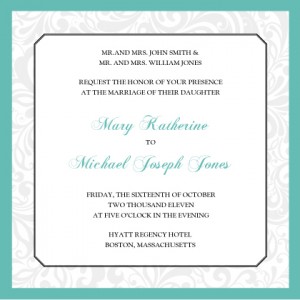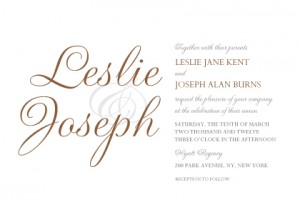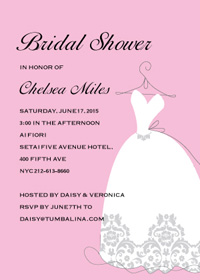Don’t feel intimidated by the concept of ‘etiquette’ when it comes to wording your wedding invitations. Etiquette is just a fancy word for the tried-and-true set of social guidelines to follow for a special occasion. And guidelines aren’t the same as rules. So when it comes to wording your wedding invitations, there can be exceptions, variations, and creative inventions that you decide are more appropriate for your style and the style of your wedding day. Etiquette is more of an art than a science!
Wording Your Wedding Invitations
Personalizing your wedding invitations with your own wording isn’t difficult once you have a handle on some basic etiquette. Here are a few of key guidelines to get you started:
Who’s Hosting?
- Parents of the Bride – Use formal titles in the third person (Mr. and Mrs. John Smith), and list the bride first (no last name if the same as both parents)
- Parents of the Bride and Groom – Add “son of Mr. and Mrs. Matthew Johnson” below bride and groom’s names
- Bride and Groom Themselves – Use the names of bride and groom only
- Bride and Groom Contributing – Use “together with their families” followed by the name of bride, “daughter of Mr. and Mrs. Smith”, and groom, “son of Mr. and Mrs. Matthew Johnson.”
- Divorced Parents – If not remarried, separate with (/) and list mother’s name first. If remarried, begin with mother’s name and new spouse, followed by father’s name and new spouse on second line.
Tip: For a more casual style or less traditional wedding, you can drop social title and use first and last names only (no Mr. or Mrs.)
How Do You Say It, Exactly?
- Religious – Use “request the honor of your presence” for a ceremony taking place in a house of worship.
- Secular – Use “request the pleasure of your company” for a ceremony taking place elsewhere
- Date – Always spell out numbers and lead with the day followed by month (“the ninth of December, two thousand and twelve“)
- Time – Spell out hours and time of day. Use the phrase “half past” for half-hours, and morning, afternoon or evening in place of a.m. or p.m. (“Half after five o’clock in the evening“)
Tip: Capitalize the first letter of the first word on every line that stands alone.
You can find illustrations of these examples and more by looking at sample wedding invitation designs when you shop online at www.looklovesend.com. You will always get to view your own custom wedding invitation wording online first before you approve your order to make sure it’s exactly how you want it. Enter our monthly Wedding Invitation Sweepstakes for the chance to win $500 towards your favorite wedding stationery!



















